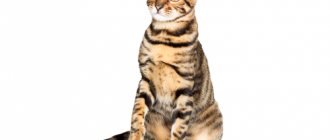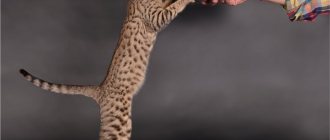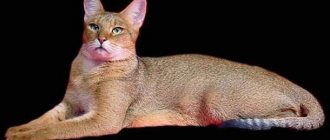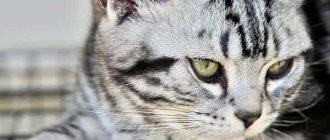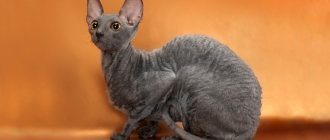The Burmese cat is one of the most beautiful pets. Burmese cats are very colorful due to their amazing color and soft length of fur. Calm, obedient, sociable and inquisitive, Burmese cats have coexisted peacefully next to humans for centuries, showing their emotional affection.
History of the Burmese cat breed
Burmese cat
The name of the breed speaks of the historical homeland of these cats, the state of Burma in the west of the Indochina Peninsula, which changed its name to Myanmar in 1989.
The first Burmese cats arrived on the Old Continent in 1919. They were recognized as a separate breed in 1925 in France. During the Second World War, the genotype of the ancestors of modern Burmese was practically lost. But as a result of selection and crossing with Siamese and Persian cats, the sacred Burma became what we know it today by the middle of the last century.
The original history of the origin of the breed, that is, the period before its appearance in Europe, goes back centuries, and it is almost impossible to establish where these very intelligent and endowed with a special charm pets came to us. What is known for certain is that in ancient times these cats lived in Buddhist temples in Burma, protecting them from raids by robbers and protecting them from dark otherworldly forces.
A picturesque legend is associated with the history of the breed, taking us back to those distant times. In one of the mountain temples, Buddhist monks worshiped the blue-eyed goddess Cun Huanze. She was revered as a conductor of the souls of the dead to the afterlife. For some reason, some monks did not go to heaven after death and, according to legend, returned to the sinful earth in the form of a cat. When black and white cats with yellow eyes began to appear on the territory of the monastery, no one had any doubts: these were messengers of Tsun Huanze. Accordingly, they were treated with special respect.
One such cat named Singh took root with a senior monk named Mun Ha. From him, as the legend says, the Burmese cat originated. One day, robbers came to the temple, wanting to profit from its riches and especially the statue of the blue-eyed goddess. The monks stood up to defend their monastery, but the forces turned out to be unequal. Mun Ha also died at the hands of the bandits, falling dead right at the feet of Tsun Huanze. And then something incredible happened. Singh jumped onto the head of the deceased owner, whose fur seemed to flare up, illuminated with a bright radiance. The robbers got scared, and the monks managed to drive them away. The faithful cat lay down next to Moon Ha's lifeless body and did not leave for a whole week, after which he died.
Burmese kitten
After these events, the appearance of the mustachioed, purring inhabitants of the monastery began to change dramatically. The eyes turned from yellow to a bright blue color, and the black and white fur acquired a golden hue. A dark mask appeared on the muzzles, and the tail and ears also darkened. Thanks to this legend, Burmese cats began to be called sacred. It was believed that if you treated a representative of this breed poorly, if you offended him, then such a person would be in trouble and would definitely be punished by higher powers.
For a long time, this breed was known only in Burma itself and other states of Indochina. The rest of the world learned about it only at the beginning of the last century, when millionaire Vanderbilt brought the sacred Burma to France in 1919. He bought two kittens, paying exorbitant amounts of money for them, but only one made it to their new home. This female individual gave birth to the first European Burmese.
The breed was officially registered only in 1925, giving it the name according to legend - the sacred Burma. She immediately gained enormous popularity in social circles of the time. Kittens were very, very expensive, and few could afford to buy them. Most likely, it was for this reason that during the Second World War the breed began to be threatened with extinction. By some miracle, fans were able to keep one cat and one she-cat. Through the efforts of breeders, Burma survived and began to expand its population.
Since the second half of the last century, the fluffy Burmese goddess began to settle in other countries. In 1966, the first blue-eyed cats came to the United States, and they were brought to the UK a year later, in 1967.
Origin story
The breed originates in eastern countries. There, in 1919, the Vanderbilt family of American billionaires acquired two kittens of the color they liked, the same ones with whose luxury Ellochka Shchukina competed in the famous novel “12 Chairs” by Ilf and Petrov. The male did not survive the return trip to Europe, but the female survived and soon gave birth to offspring. The first registration in the French Register dates back to 1926. During the Second World War, the Burmese breed was in danger of extinction; the number of representatives was able to be restored by the 50s of the last century.
Also read about Siamese cats in a separate article.
Appearance of a Burmese cat
The Sacred Birman is a medium-sized cat whose coloring resembles that of its Siamese cousins. Her fur is soft and delicate. Ideally, an individual of this breed has long and silky fur and a color point color. A distinctive feature of the Burmese, one might say, their calling card is their bright blue eyes and white “socks” on their paws.
Fluffy handsome man
These cats are especially loved by those who are delighted with the color of the Siamese, but do not like the latter for their thin structure and wayward behavior. Fans of Himalayan cats also find an outlet in the sacred Burma, but those who do not like the latter for their short and squat body. The Burmese cat is a real find in this regard, it is a kind of middle option, a kind of balance between these two breeds. And as a “bonus”, the owners receive her easy-going character and easy-going personality.
Head
Among the Burmese it is proportional, almost round in shape, wide and expressive. The length is somewhat greater than the width; the forehead, against the background of a rather rounded skull, is distinguished by some convexity.
The muzzle is well developed: wide, rounded, with full and prominent cheeks. She seems to be “hidden” under a dark mask. Cheekbones stick out. The chin is strong and strong.
The nose is of medium length, “Roman”, the transition (TICA) from the forehead to the muzzle is clearly defined (FIFe - without transition).
Eyes
The Burmese cat's eyes are large, expressive, almost round in shape, and set wide apart. Sapphire blue, their color can vary from light blue to dark blue. Dark eye shade is preferable.
Ears
Located on the sides of the head, a slight forward tilt is noticeable. The size is medium, the tips are rounded. They can be placed both moderately and widely. The inner part of the auricle is expressively pubescent.
Neck
The neck of Burmese cats is short to medium length, muscular and wide.
Muzzle of a Burmese cat
Body
Squat, elongated in shape and dense in constitution, with well-developed and strong muscles. The bone structure is powerful. The average weight of an adult Burmese cat is about 6 kg.
Legs and paws
The legs are thick, strong, of medium length, and muscular. With existing color variations, rings may appear on the legs. Large, strong and round paws, with tufts of hair between the toes.
Tail
Fluffy, medium length, uniformly dark color. Fluffy tip. The Burmese usually carries his tail up.
Color
Burmese cat with red markings
Burmese cats are characterized by different variations of color points; these can be gray-blue and dark brown, red and chocolate, cream and lilac. The palette of the rest of the coat can vary from white to cream.
Pigmentation, like in Siamese cats, is allowed only on the face (the so-called “mask”), ears, limbs and tail. Another sign of the Burmese is their white paws, “shod” in “slippers” (or “socks”) - a touch of white, without impurities, color on all four limbs.
The fur on the paws is an impeccable white color and on the front legs it does not rise above the pastern. On the hind legs, the “slippers” end in a sharp “spur.” It is located at a certain distance (1/2 or 1/3) between the hock joints and the large pad of the paw. The color of the pads also varies, the following variations are allowed: pink, dark brown, coffee with milk, pink with dark spots, cinnamon colors.
Burmese kittens are born with an immaculate white color. O begin to appear after 1-2 months. The final coloring is established only in adult individuals. Over the years, the fur darkens.
Possible defects
Eye color that is far from the accepted standard. Silvery shine in one or both eyes, squint. The presence of white or colored spots on the chest and belly, as well as the head, like Persians and Siamese. Non-standard tail structure.
Disqualifying faults
The absence of white “slippers” (“socks”), “spurs” and “gloves” and the presence of white patches on colored areas of the coat.
Knobbiness or curvature of the tail. Excess of the “spurs” of the hock joint.
Spots where they shouldn’t be: colored – on light fur or “gloves”, white – on points. Colored spots on paws.
Color
The Sacred Burmese cat has a pointing coat color. This means that the cat has light beige fur with a golden tint, which turns white closer to the belly and chest.
There are dark markings on the face, ears, paws and tail, and the white “socks” characteristic of this breed are present on the tips of the paws. The eyes are large, widely spaced and bright blue.
It is worth noting that all kittens of this breed are born pure white, but as they grow up they acquire recognizable features of this breed.
Note!
Singapore cat: character, photo, price, breed description, reviews, how to buy, how to choose, maintenance, care and owner reviews
- Scottish Straight: cat photo, kitten prices, breed description, character, reviews, maintenance and care, nutrition + interesting facts
Chausie - overview of the breed, character and breeding characteristics. Price for a kitten and tips for choosing a purebred cat (115 photos)
The toes on the hind legs of the Burmese beauty are longer than on the front ones. Also, if you look closely, you can see the “spurs” on the back of the “toes” in a “V” shape. The symmetry of the “socks” is highly valued among breeders.
The sacred Burmese breed has many varieties of colors. So, for example, colored markings can be red, blue-gray, chocolate, lilac-gray or cream.
However, the most famous is seal point, when the spots are dark brown. In any color variation there are always white “socks”.
Photos of Burmese cats
Difference between Burma and Burmese
Despite the similar names, the Burmese cat differs in many ways from the Burmese. The most characteristic feature of the first breed is the silky coat, as well as the color - there are no white “gloves” and “socks”, dark markings on the face and limbs. The Burmese breed has brown, blue, sable and other types of colors.
Unlike Burmese, they have a different shape and set of eyes, the color of the iris is most often brown and its shades.
What does a Burmese cat look like?
Personality of Burmese cats
This graceful Asian beauty is distinguished by her extraordinary intelligence and intelligence. It seems that she understands the owner almost perfectly. When someone is talking, a Burmese person looks carefully into the eyes, literally peers, as if he understands what they are talking about and even tries to grasp the hidden meaning. Buddhist monks, who noticed such a feature in cats of this breed, nicknamed them “the eye of heaven.”
Burmese kitten with toys
The character of Burmese cats, as they say, is without extremes. They are not observed to be excessively passive, but they also do not have an overly violent temperament. These pets are calm and balanced. Playfulness, friendliness and affection are the main features of the sacred Burma for which she is loved. These wonderful qualities, oddly enough, are more pronounced in males, although it would seem that the opposite should be the case. When playing with their owners, intelligent Burmese cats will never scratch in the heat of excitement. The ability to “control oneself,” as a true sign of a noble breed, is clearly in their blood.
The Burmese cat does not tolerate loneliness and does not distance itself from other animals in the house; it easily gets along with cats of other breeds and even dogs. But if the owner pays a little more attention to other pets, the Burmese may become jealous. Representatives of this breed get along well with children and enjoy playing with them. If the atmosphere in the house suddenly becomes tense and a scandal is brewing, the wise sacred Burma in some incomprehensible way can defuse the situation, making household members smile and forget about quarrels.
At the same time, representatives of this breed have an independent character, and this independence manifests itself more and more clearly as they grow older. It seems that the famous writer Rudyard Kipling copied his “Cat that Walked by itself” from them. If a Burmese doesn’t want to, you can’t keep him in the room by force. He loves to walk in the fresh air, indulge in games in the garden or in the garden, and go outside.
This cat can watch the fire for hours
Despite the fact that affection, playfulness and friendliness are the usual state of the Burmese, they are characterized by frequent mood swings. They often exhibit such traits as excessive curiosity, excessive persistence and, at times, extreme intrusiveness. Achieving its goal by any means, the Burmese cat sometimes angers its owners, who, irritated, can offend it. In such cases, the Burmese immediately changes mercy to anger - he shows aggression. If you offend him very much, then he can leave such an owner forever. Representatives of this breed also do not tolerate indifference towards themselves.
In order to diversify the “leisure” of these animals and for them to feel that their owners are not indifferent to them and truly love them, it is necessary to create conditions for their full development from an early age. It would be nice to arrange a kind of “teremok” for them, where they could play and relax. Burmese are easy to teach simple commands to a certain place in the house and to a scratching post. They form a strong attachment to their owner, but can tolerate long-term separation painlessly.
Despite such a trait as obsession, the Burmese cat is not alien to tact. If she feels that the owner is not in the mood, she will not come again for a portion of affection, but will wait for a more opportune moment.
Who's the cutest cat here?
Flaws
Burmese cats do not like cold and drafts, and it is better not to walk them in the fall or spring due to strong winds.
One noticeable disadvantage is the very high price of the sacred Burmese cat.
The price of a Burmese cat ranges from 20,000 rubles to 70,000 rubles. Therefore, be sure to check with the seller for all the details, make sure that he can be trusted, as he may turn out to be a scammer who will sell an ordinary Persian.
Be sure to look at the attached photos of the sacred Burmese cat that you plan to buy. Perhaps she will have features that are not at all characteristic of this breed.
Care and maintenance
Myanmar is one of the hottest countries on our planet, so it is not surprising that its native is a very heat-loving animal that cannot tolerate drafts. We are used to the fact that ordinary domestic cats can sleep on a rug or in a chair, but only the Burmese cat prefers to sleep under a blanket. She is completely unsuited to life in the yard and on the street, especially during the cold season. Sacred Burma does not accept precipitation; it is openly afraid of it.
The characteristic features of this breed are also manifested in the structure of the vestibular apparatus - its representatives land poorly. Therefore, if you let your cat out onto the balcony, be sure to put a net on the window so that your pet does not fall down when, driven by natural curiosity, it begins to explore everything around.
The coat of Burmese cats does not require special care. They do not have an undercoat, so brushing with a special brush is sufficient once every two weeks. Daily hair care is required only during the molting period - to avoid the formation of tangles on it. Ears also require simple hygiene procedures: it is enough to wipe their inner surface with a damp swab twice a month.
Bathing Burmese cats is a different story. They do not like water procedures, so be patient. Bathing takes place quickly and without much nerves only if the Burma is accustomed to this from an early age.
Character and temperament
The Sacred Birman is a calm, balanced and moderately active cat. She is very friendly, affectionate and playful. At the same time, she knows how to control herself and shows nobility in any situation.
The Burmese cat, whose character combines the desire for independence and dislike of loneliness, will not tolerate an indifferent attitude. She gets along with children without any problems and even in the midst of play will not scratch a child.
The Sacred Birman is able to coexist peacefully with non-aggressive dogs and cats of other breeds. But it is better to keep ornamental birds, rodents and aquarium fish away, since the hunting instinct in a cat can awaken at any moment.
Feeding
The diet of Burmese cats must be balanced. Unlike many people, they are not prone to food addiction. No matter how much food you leave for your Birma, she will eat exactly as much as she needs without overeating. In addition, in addition to natural activity, they have a good metabolism, so they are not in danger of becoming overweight either at an early age or in adulthood.
Om-Nom-nom
At the same time, our Indo-Chinese aristocrat is a real gourmet, that is, she loves to eat deliciously. For her, it is not the quantity of food that matters, but the quality. Natural meat food is the main priority in her menu. If you treat your pet to turkey, beef or chicken, he will be very grateful to you and will respond with even more love. Some individuals enjoy eating boiled fish. But fatty meat and foods containing salt should be excluded from the diet of these cats, as this is fraught with harm to their health: the kidneys and liver may be damaged.
Many of us are accustomed to feeding our pets food and dishes “from the table,” that is, ordinary everyday food that the whole family eats. The sacred Burma cannot be given such food! Spicy and smoked foods should also not be included in her diet. You can add ready-made food to the menu, but only if it is a top quality product. Cheap food, of course, will not kill your pet, but it can negatively affect the condition of its coat and skin, as well as its digestive tract.
The diet of small kittens should include low-fat minced chicken and beef, and fermented milk products. Such a menu will be the key to preserving the brightness of the coat in adulthood. For babies to fully develop, they need to be fed 4-5 times a day, the serving size should not exceed 150 grams. Fermented milk products should also be given to adult cats, which is beneficial for their health. Elderly and older cats are usually fed twice a day, with a single serving of 200-250 grams.
Let's shine
Severe Burmese cat
Coat
The fur of Burmese cats is fluffy and quite long. At the same time, it is very soft, silky, and easy to care for, since tangles do not appear in it.
Around the neck, the fur is much longer and more luxuriant, forming a so-called “jabot”.
In the belly area the coat is slightly wavy. The tail is very fluffy, the hair towards the end of the tail is longer than at its beginning.
On the face, the hair, like that of all cats, is very short, but closer to the body it becomes more luxuriant.
Health and diseases of the Burmese cat
Diseases of hereditary and genetic nature are rare in representatives of this breed, and all thanks to careful selection. In general, the health of Burmese cats is quite good. By making it a rule to regularly visit the veterinarian for preventive examinations and routine vaccinations, you thereby guarantee your pet an active life and longevity.
Cute Burmese kitten
The Burma's lifespan ranges from 12 to 14 years. There are happy exceptions to this rule - for example, the cat Lady Catalina. This representative of the Burmese breed from Melbourne, Australia was born on March 11, 1977 and lived for 35 years, getting into the Guinness Book of Records thanks to her longevity record. Burmese cats are also distinguished by their fertility; the number of kittens in one litter can reach 10. It is a documented fact that a cat gave birth to 19 babies at once, and this is also a record.
In some very rare cases, Burmese people suffer from a heart disease called hypertrophic cardiomyopathy. Its symptoms - shortness of breath and cough after active games, lethargy - usually begin to appear from an early age. Burmese cats also have pathologies of the vestibular apparatus and corneal dermoids. The latter can be successfully treated with a course of special antibiotics, but provided that the disease is not advanced. Regular deworming and age-appropriate vaccinations are provided as preventive measures.
In order for a cat to wear down its claws, it must be accustomed to a scratching post. Try to place the house or bed for your pet low, since climbing almost to the ceiling is not the style of the sacred Burma, she is a sedate animal. The bed should be made from natural materials; any “chemistry” can negatively affect the health of the Burmese.
Pros and cons of the breed
By purchasing a purebred Burmese, the future owner receives a unique animal. Fans of the Sacred Burma breed claim that they are not at all like other cats, highlighting a number of advantages:
- Unusual, noble appearance. The breed can rightfully be called elite. The fluffy fur, the unusual color and the intense gaze of blue eyes are striking.
- High level of socialization. They say that the Burmese feels the owner and interacts with him. These cats are friendly, sociable, balanced, and tactful.
- Balanced character. Kittens easily adapt to a new home and accept the laws of family life. Usually there are no problems with toilet training or scratching posts. The Burmese are not vindictive and do not tend to damage wallpaper or furniture.
- Sacred Burma has good health and long life expectancy. With satisfactory care, they live freely up to 18 years, and sometimes longer. If you regularly bring your pet for medical examination, then there is a high probability that he will live a long life without suffering from anything serious.
- Easy care, moderate shedding.
There are also disadvantages:
- Due to the lack of undercoat, the Sacred Burma is prone to colds. Excessive exposure to cold air can cause the coat to darken.
- Burmese are jealous, which creates problems when keeping multiple animals in a family.
- Sacred Burma requires healthy eating and careful selection of diet. Due to their sensitive digestive system, economy class food is not suitable for them.
- The price of kittens is very high. A purebred baby costs from 40 to 200 thousand rubles.
How to choose a kitten
When buying a Burmese kitten, or any other breed, you want to be sure of its breed and health. Purchases from hand or in online stores cannot guarantee this. The most reliable way not to make a mistake is to buy a kitten from a certified nursery. The owners of such establishments, as a rule, value their reputation, paying special attention to the health of kittens, their upbringing and social adaptation. Here your future pet will be vaccinated against infectious diseases and dewormed. When leaving the nursery, the kittens will come to your home already adapted, sociable, accustomed to the tray and scratching post.
Many people, at their own peril and risk, still buy Burmese kittens not from certified nurseries or even secondhand. In this case, carefully examine the kitten. A baby who has no health problems is usually cheerful and active, has clear eyes, clean ears and a shiny, thick coat. Ask if the kitten has been vaccinated, if it has a veterinary passport, and what the baby was fed.
If you notice discharge from the nose or eyes, then it is better not to buy such a kitten - it will cost you more.
Nurseries
In Russia, the Burmese cat breed is widespread and it is not difficult to find a cattery with a high rating. There are several breeders of sacred Burma in Moscow:
- Adoration. The owners are strict about selling kittens, not handing them over to inexperienced amateurs for breeding.
- TARNIS*RU. Burmese kittens of various shades of color point are bred here.
- Nyan House. The nursery provides a large selection of animals that come from champion Burmese.
- Astra Venetum.
In addition, Burmese kittens can be found in Tyumen, Khabarovsk, Nizhny Novgorod, Rostov-on-Don and other large cities in Russia. Due to the characteristics of the breed, the characteristics of the animals do not depend on the region, so a beautiful cat can be bought at any nursery.
Photos of Burmese kittens
Difference from Ragdolls
Ragdolls differ from Birmans in their wedge-shaped head, widely spaced ears, and nose, which has a special proportion - the width is exactly half the length. For Ragdolls, spots on the paws are allowed, while for Burmese this feature is a factor for disqualification at the exhibition. In addition, representatives of this breed differ in character and temperament. Cats are calmer, less active, and also have the ability to relax the muscles of the entire body, hence the name “rag doll.”
Two Ragdoll cats
How much does a Burmese cat cost?
Catteries specializing in breeding Burmese cats are very rare in Russia.
Buying purebred kittens can cost a fortune. So, a show-class specimen will cost your wallet about 70 thousand rubles. Breed class is cheaper, about 60 thousand. A pet-class kitten will cost even cheaper, about 50 thousand rubles. A Burmese kitten without accompanying documents can be purchased for only 10 thousand rubles. Such animals are usually born from unplanned matings and, accordingly, will have no pedigree. It is not recommended to purchase kittens at bird markets, through dubious advertisements or from random persons. There is a high probability that such a Burmese will have bad heredity and will have a whole bunch of diseases. Many connoisseurs of the breed take such risks to save money. To minimize them, when purchasing, pay attention to the general condition of the future pet. The kitten should be strong, not lethargic, with thick shiny fur, without purulent discharge from the eyes and ears.
When all doubts are left behind and you decide to make a purchase that ultimately turns out to be successful, rest assured: from now on you will have a faithful friend next to you for many years to come. Representatives of the Burmese cat breed are very noble creatures who invariably respond to attention and care with great love and devotion.
How much does it cost and where to buy
In order for a female to have purebred Burmese kittens, mating must be done at the age of one and a half years.
In one litter, from 3 to 7 kittens are born, in a rare case - 10 cubs. Purebred Burmese kittens can be purchased in Moscow nurseries or from reputable breeders.
Choosing a kitten
When choosing a Birman kitten, you need to carefully prepare. The price for Burmese kittens starts from 20 thousand rubles. The cost of a Burmese baby depends on the age of the kitten and the purity of the breed. The cub can be given away at the age of one month, when it begins to eat on its own. To achieve good immunity, Burmese kittens are given the necessary vaccinations.
Why is Burma considered sacred?
Myanmar is a state located in Southeast Asia, until 2010 it had a different name - Burma. In ancient times, a large number of temples were located on the territory of the state, in which people worshiped the goddess who was responsible for dead souls. This deity was believed to have bright blue eyes. Each temple was home to many cats with white fur, and the most important one, Sinh, was assigned to each high priest. One day there was an attack on the sacred place by robbers who killed the priest. Then Singh jumped on the dying old man and revived him, while all the cats in the temple changed color and eye color.
1111

